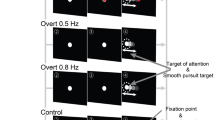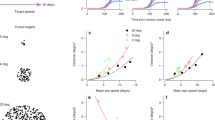Abstract.
The cortical medial superior temporal area (MST) is essential for the normal execution of smooth pursuit eye movements. Many pursuit-related neurons (visual-tracking neurons = VT neurons) in the lateral part of area MST (MSTl) are responsive to retinal image slip (r) as well as to eye (e) and head velocity (h) with similar preferred directions (isodirectionality). We show, by running a connectionist network with VT neuron-like elements, that an assembly of MSTl-VT neurons is able to reconstruct target motion in world-centered coordinates (t′). When t′ is fed into a subsequent model stage, converting t′ into gaze velocity (g′) with varying contributions of e and h, the overall model is able to account for many of the salient properties of visually guided pursuit including the consequences of MSTl lesions. However, the analysis of the MSTl network also clearly indicates that isodirectionality is not a prerequisite for its performance. The investigation of a second model suggests that isodirectionality indeed does not result from functional but from developmental constraints. This second model is a connectionist network with hidden units, which similar to MSTl-VT neurons receive input from modality specific units encoding retinal slip, eye and head velocity. After training this network to offer t′ as output, two subsets of hidden units emerged, one exhibiting isodirectionality, but not the other. Since only isodirectional hidden units contributed to the flow of information, the preponderance of isodirectional MSTl-VT neurons might be the result of developmental pruning, eliminating the second group.
Similar content being viewed by others
Author information
Authors and Affiliations
Additional information
Received: 17 April 1998 / Accepted in revised form: 28 July 1998
Rights and permissions
About this article
Cite this article
Dicke, P., Thier, P. The role of cortical area MST in a model of combined smooth eye-head pursuit. Biol Cybern 80, 71–84 (1999). https://doi.org/10.1007/s004220050505
Issue Date:
DOI: https://doi.org/10.1007/s004220050505




